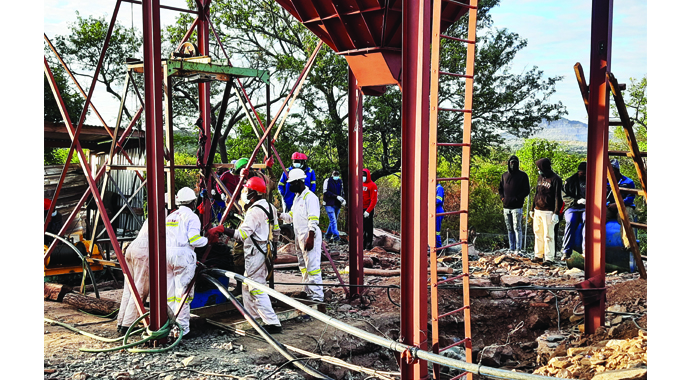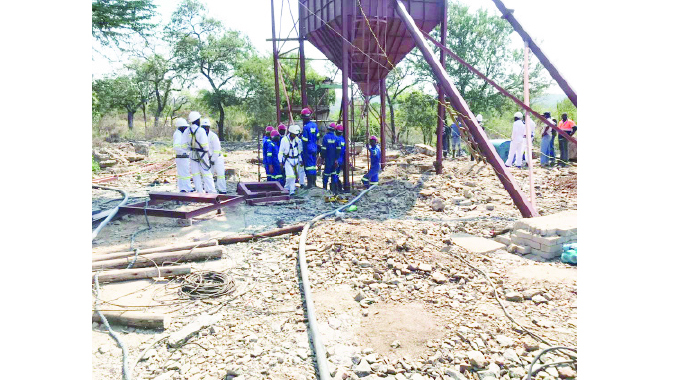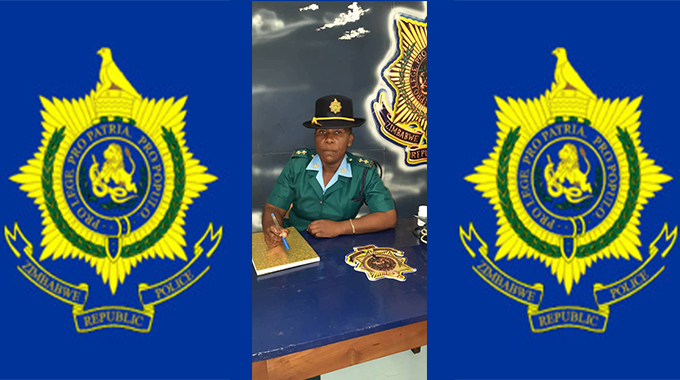Mine tragedy: Governement unearths irregularities

Yoliswa Dube-Moyo, Matabeleland South Bureau Chief
PRELIMINARY investigations into the Bucks Mine accident in Colleen Bawn at the weekend which claimed the lives of seven miners indicate that the equipment that was in use had not been certified by the Government inspectorate.
Before any mine in the country begins operations, all moving and non-moving equipment should be inspected and certified by the chief Government mining engineer before it is commissioned.
Investigations have revealed that health and safety regulations were not followed, leading to the death of the seven miners after hoisting ropes to the skip bringing the miners to the surface snapped, plunging them down a 240-metre-shaft.
Chief Government Mining Engineer Michael Munodawafa said the cocopan that plunged had seven miners but it was supposed to carry four people.
He said the rope had not been approved by the Ministry of Mines and Mining Development inspectorate.
“Investigations are still ongoing but one of the major issues is the non-commissioning of the equipment at the mine. Any moving and non-moving equipment should be commissioned. Even the shaft itself should be commissioned. We’re supposed to come and inspect as well as certify the equipment.
Once it’s certified, it means the problem has moved from the mine owner to the regulating authorities. We’ve found out that an eight-millimetre wire rope was used, which was not enough to hold a one-tonne cocopan. The rope should’ve been at least 13 millimetres and above. Also, a cocopan takes four people but they put seven.
The rope itself is supposed to be commissioned by the Ministry of Mines and Mining Development inspectorate but not even our Gwanda or Harare offices have any documentation pertaining to the commissioning unless the mine owners can prove otherwise. We keep a copy in Gwanda, another in Harare and one for the miners,” said Mr Munodawafa.
He said it is important for mine owners and workers to follow health and safety regulations in order to prevent accidents.

The shaft where the accident occurred
“We don’t want the same thing happening, day in, day out. Before any mine owner starts operating, an environmental impact assessment should be done. In their plan, they must show how they’re going to protect the environment. The mining plan should also highlight whether or not a shaft will be sunk, how deep it will be, how far apart the shafts will be and so forth.
In some cases, you find that the shafts may be too close together. We don’t allow that because with time, as you blast, the whole thing can collapse,” said Mr Munodawafa.
Turning to the slow pace of the rescue mission of the trapped manners which spanned over 72 hours, Mr Munodawafa said the area was confined which limited the number of rescue workers that could be deployed to do the job.
“If you get too many people, they’ll be chaos and it’ll be difficult to work. In most cases, we do such retrievals at night, when everyone is gone. But the nature of this accident was not going to spare any lives. It would’ve been a miracle if any of the miners survived. I’ve however, seen miracles happen in the mines.
We retrieved some people at Battlefields near Kadoma who had been trapped in the mine for six days with water getting up to their necks. They had not been eating for all those days but they survived. In Mutoko, we saved two young boys after three days,” said Mr Munodawafa.

Zimbabwe Miners Federation Matabeleland South chapter chairman Mr Philemon Mukwili said there was a need to scale up training and awareness campaigns on mine safety to prevent similar accidents in the future.
“We saw this accident as a challenge to us because we now understand that most small-scale miners lack knowledge of health and safety which is very important in our mining operations. We’ll be training our miners so that they understand the importance of safety in the mines.
Most miners were not taking issues of health and safety seriously such that when we called for training, most miners were not coming. However, these trainings will be useful in reducing accidents in our mines,” said Mr Mukwili.
He said the organisation had engaged the Midlands State University and the Zimbabwe School of Mines to start the training next month.
“We’ll be targeting the miners on the ground so that they understand the importance of health and safety and the need to protect the environment when doing mining activities,” said Mr Mukwili. – @Yolisswa











Comments